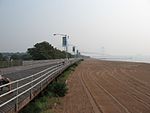Lower New York Bay

Lower New York Bay is a section of New York Bay south of the Narrows (the strait between Staten Island and Brooklyn). The eastern end of the Bay is marked by two spits of land, Sandy Hook, New Jersey, and Rockaway, Queens. The waterway between the spits connects the Bay to the Atlantic Ocean at the New York Bight. Traversing the floor of the Bay southeasterly from the Narrows to the Bight and beyond is Hudson Canyon. Roughly the northeastern portion of the Bay from the Narrows to Sandy Hook is known as the Lower Bay (named in relation to the neighboring Upper [New York] Bay); roughly the western portion of the Bay (including the portion at the mouth of New Jersey's Raritan River) is called Raritan Bay; and roughly the southeastern portion of the Bay (that is, the portion south and the portion southwest from Sandy Hook) is known as Sandy Hook Bay.
Excerpt from the Wikipedia article Lower New York Bay (License: CC BY-SA 3.0, Authors, Images).Lower New York Bay
New York Staten Island
Geographical coordinates (GPS) Address Nearby Places Show on map
Geographical coordinates (GPS)
| Latitude | Longitude |
|---|---|
| N 40.516666666667 ° | E -74.049722222222 ° |
Address
Staten Island
New York, Staten Island
New York, United States
Open on Google Maps










